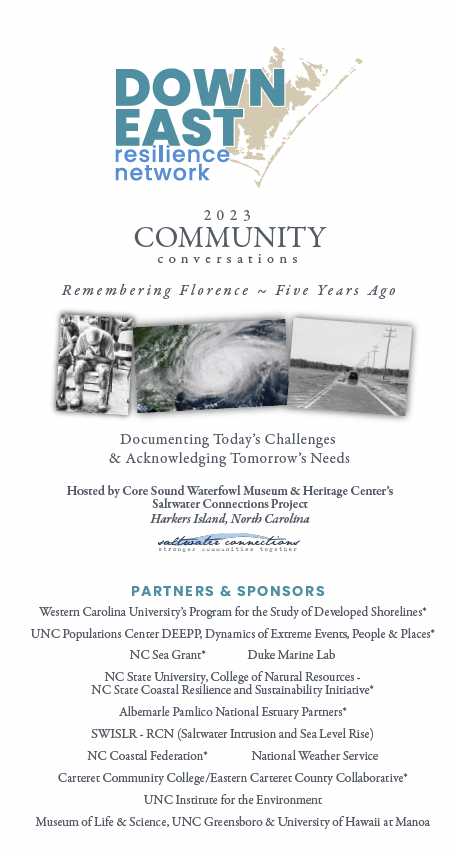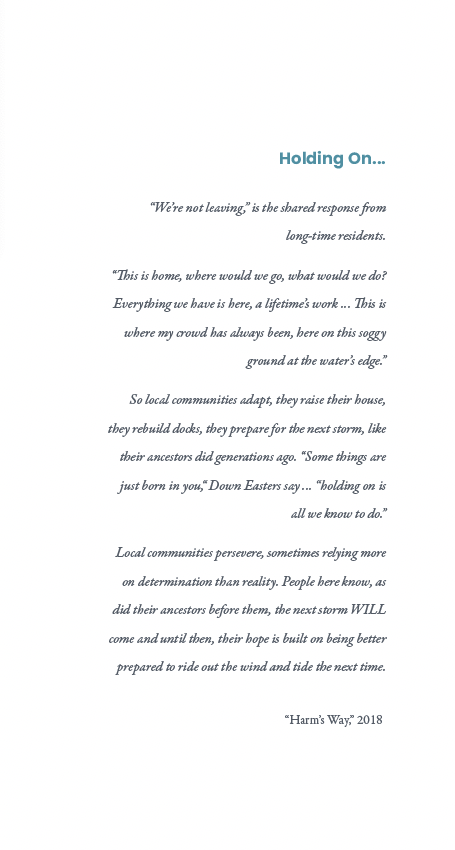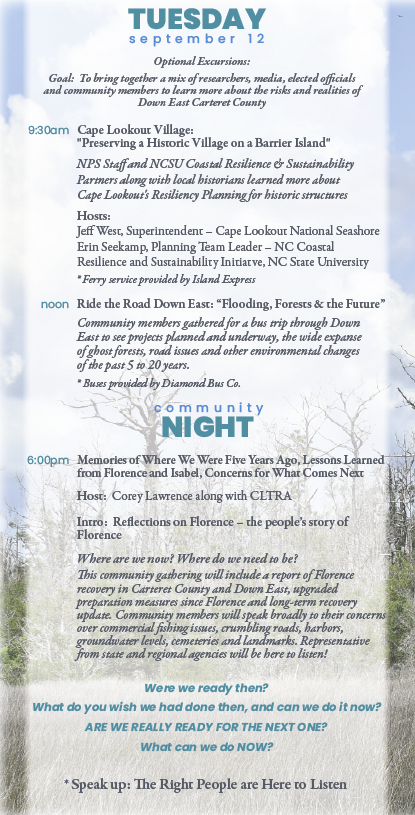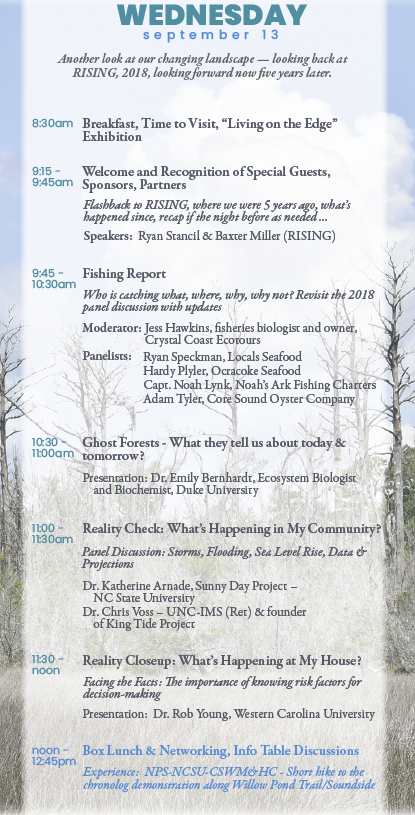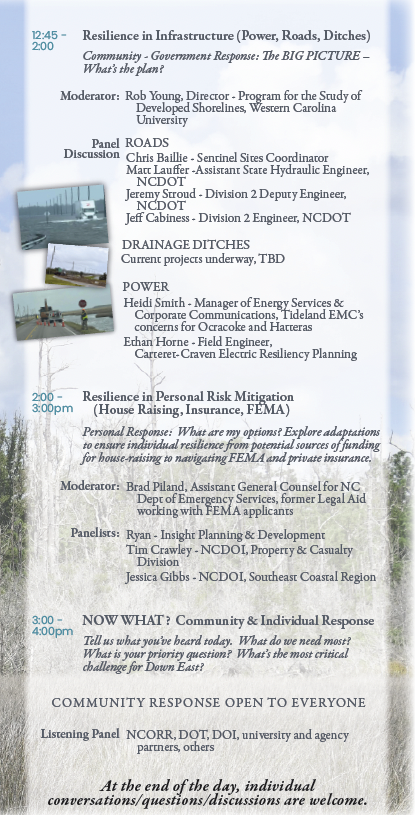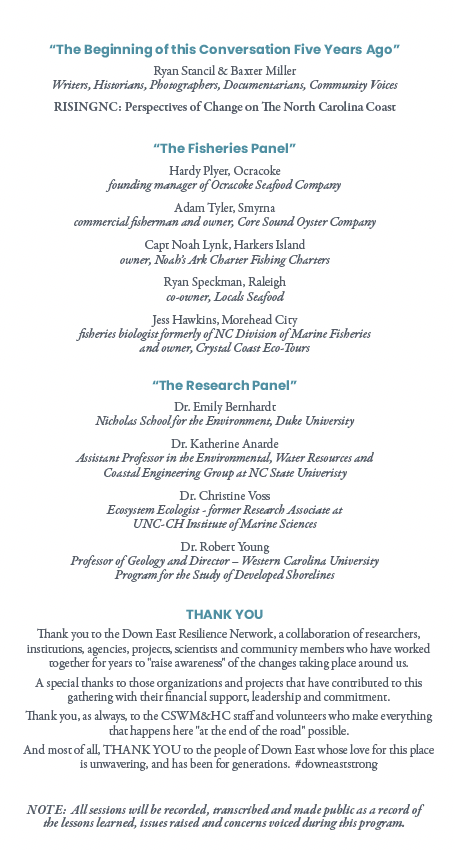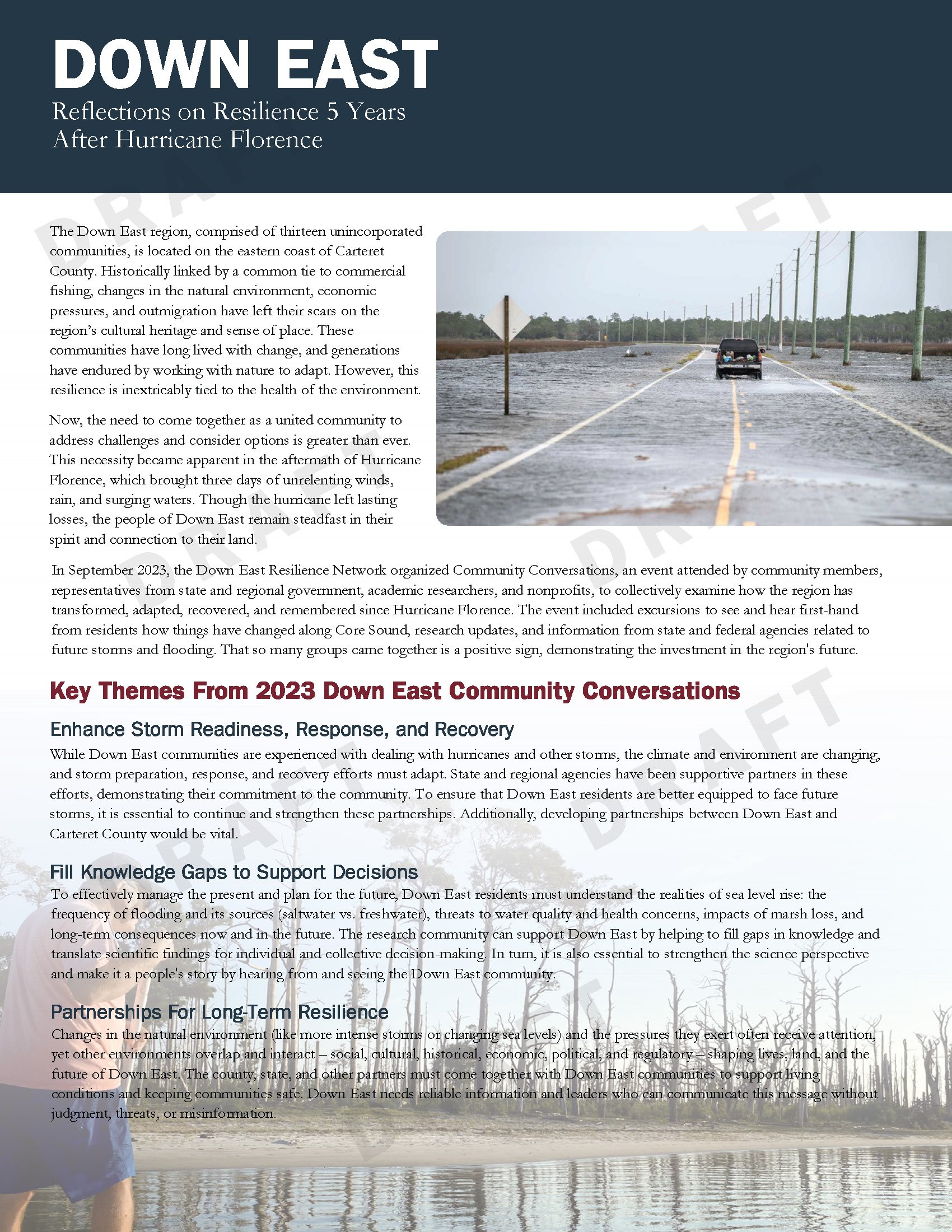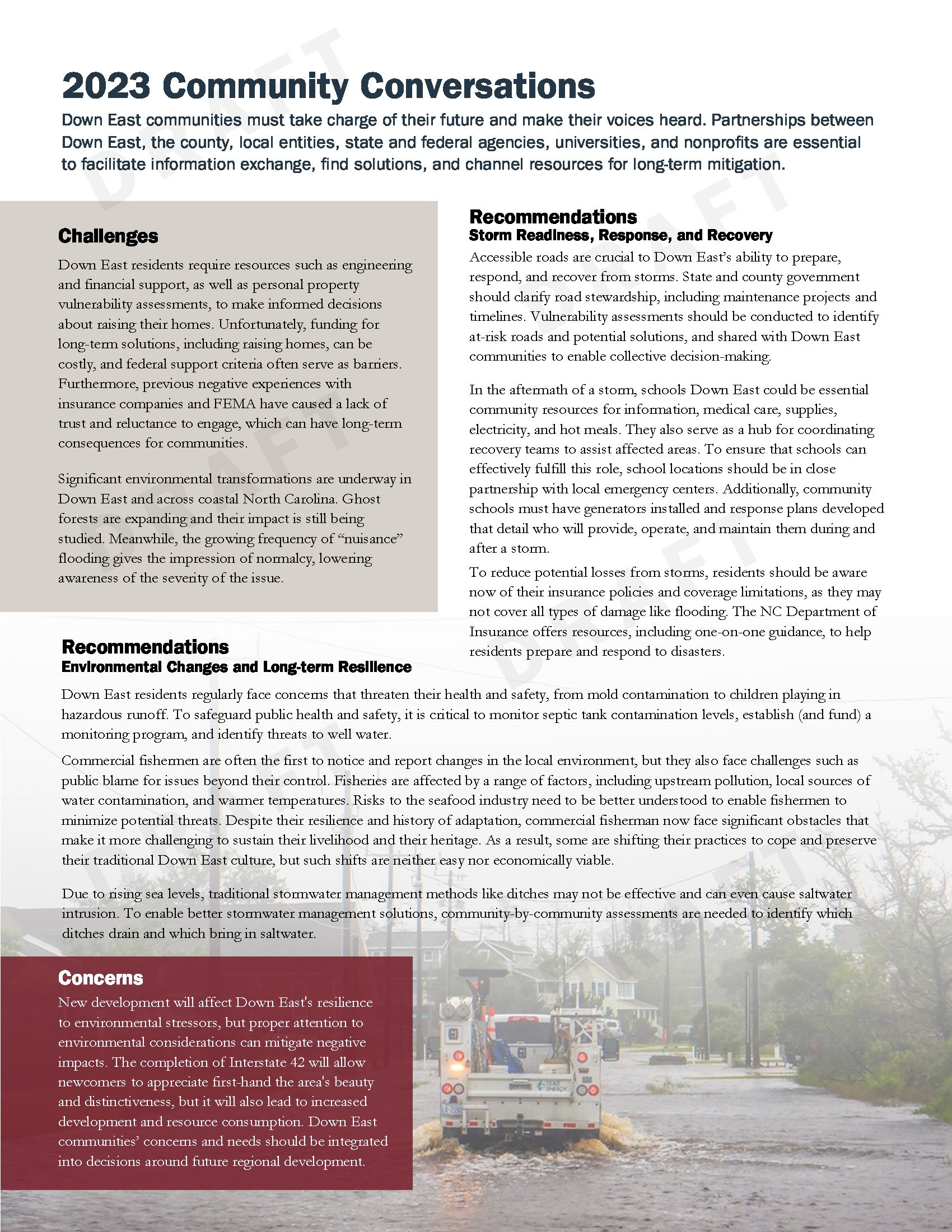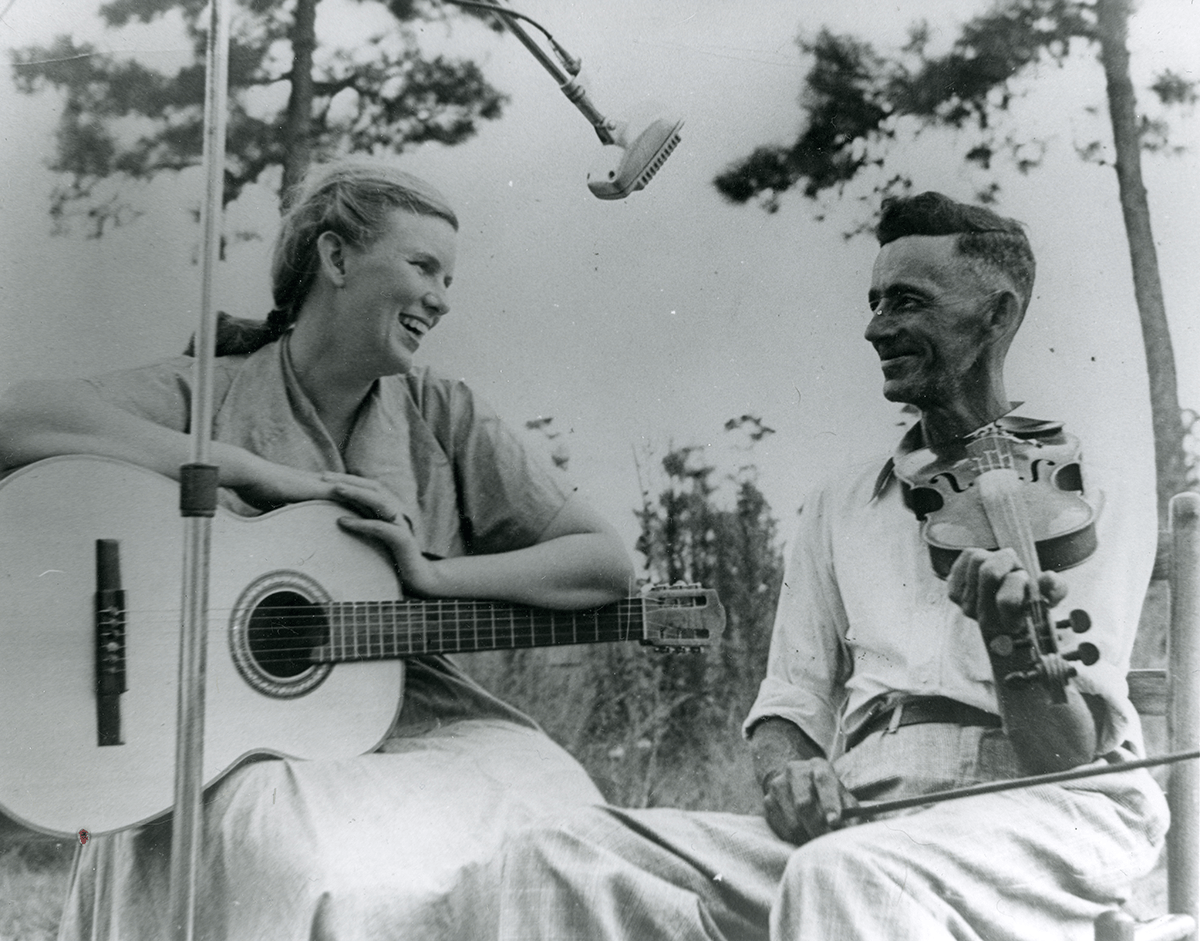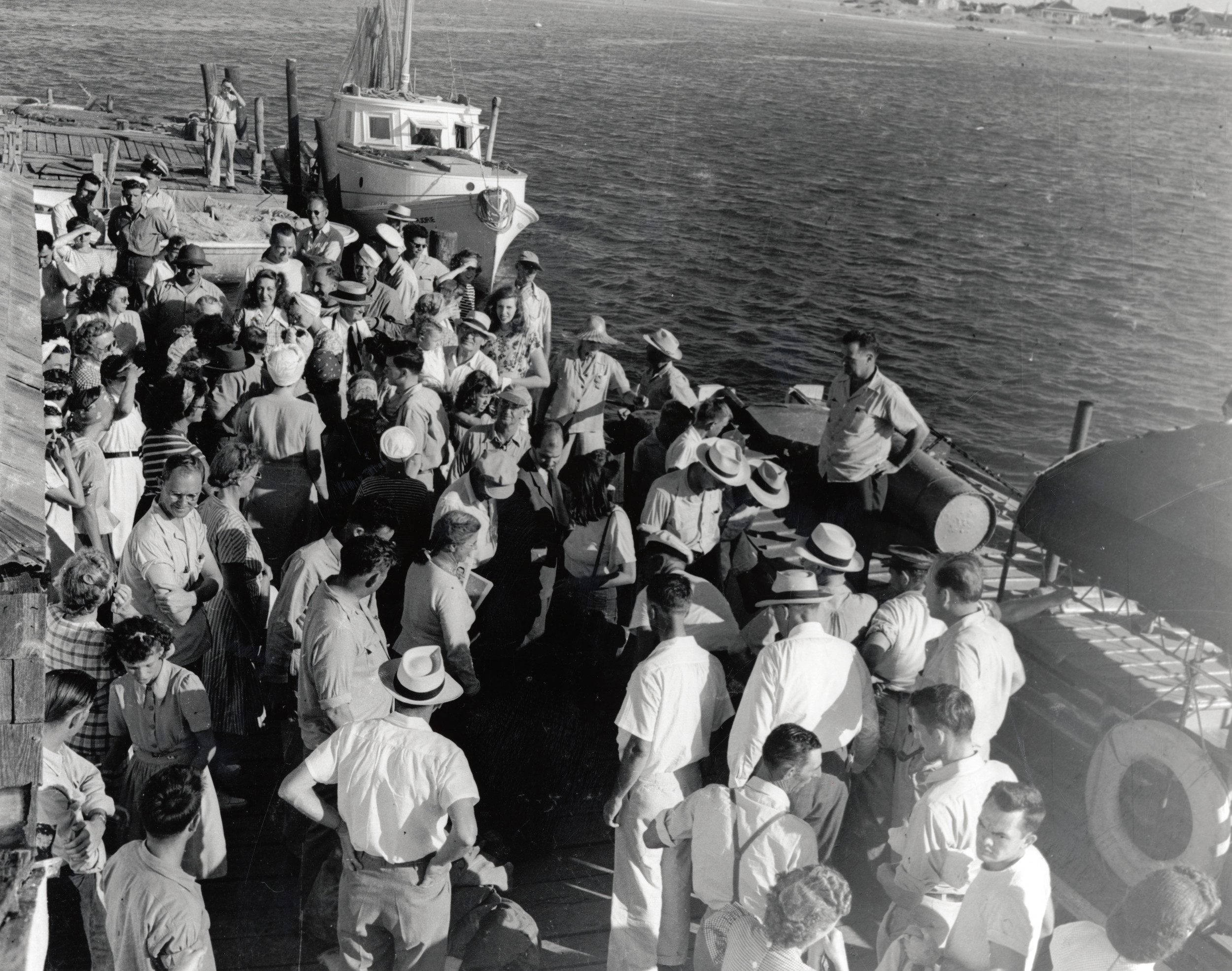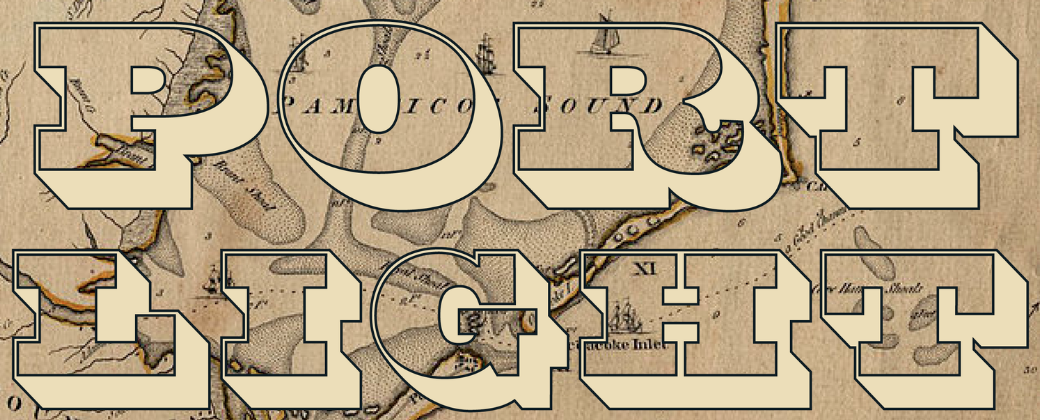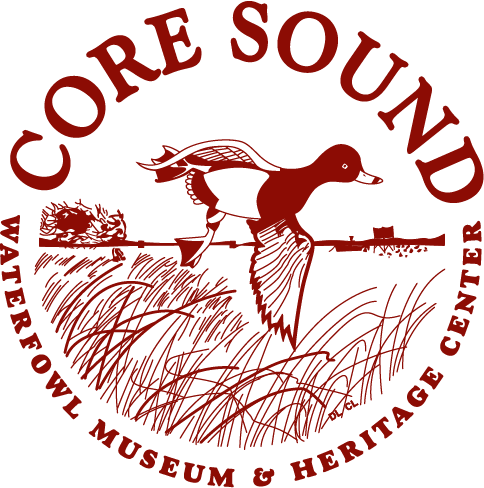museum projects & outreach
Core Sound’s community work only begins at the facility on Harkers Island. The Heritage Center’s vision and impact can be found in classrooms up and down the coast, in community meetings along the Outer Banks, in university classrooms inland and as an online resource for oral histories, educational partnerships and sustainable economic development for coastal communities.
Core Sound’s projects and outreach programs envision coastal communities of eastern North Carolina in which culture, community, education, economy and the environment are fully integrated for a high quality of life for all residents.
Down East Resilience Network
Ryan Stancil (RISING) Opening Remarks:
It’s my pleasure to welcome you to Down East - after you cross that North River Bridge you enter a watery part of the world where the only constant is change. A place where there is certainty in the uncertain.
North River Marsh Jan 3, 2022
Five years ago, this world changed swiftly. Florence sank her teeth into Down East - gnashing at the banks, shoving water up through the marsh and into the 13 unincorporated villages. She dumped nearly 30 inches of rain and left in her wake damage and flooding like we’ve never seen. Homes destroyed, business at a standstill, and livelihoods in jeopardy.
People here were battered and bruised. But, if you know anything about Down East, you know the people are strong, self-reliant, and resilient. In the days, weeks, and years that followed, like their ancestors, they have held close to another. Neighbor helping neighbor. Sharing supplies, helping one another rip up carpet and tear out drywall.
It’s hard to believe that even five years later, some folks are still picking up the pieces and trying to put their lives back together. Florence took away a lot but she couldn’t damper the spirit of this place. As Karen likes to say, the anchor holds.
I’ve heard Ernie Foster from Hatteras say every generation has a storm that defines them. For Hatteras that’s Isabel. For Ocracoke it’s Dorian. For this generation in Down East, that storm is Florence. She was a wake up call that started a long list of hard questions.
Were we prepared enough?
How can we be better prepared next time?
What do all the changes we’re seeing mean for our daily lives in the next 10/20/30 years?
How can we best adapt to hotter summers, higher water, and heightened storm impacts?
And for many, the most important question, will my children be able to call this place home?
So much has changed since Florence came ashore.
We’ve gone from asking how we were going to afford insurance to wondering if we’ll be afforded the chance to buy insurance at all.
Families have watched the back yard their kids used to play in become a marsh their grandchildren play beside.
Those whose families descend from Diamond City on Shackleford Banks find themselves asking the same question their great grandparents asked, what will I do if saltwater gets in my well?
With every northeast wind, we worry about our graveyards washing away.
Fishermen watch as flounder and shrimp move North and wonder what they’ll be able to fish for next year.
We notice the old pine forests that line our sounds and mashes turn to graveyards full of skeletons of hundred-year-old trees
And countless people, probably some of you here today, question if you should raise your house, by how much, and wonder how you’ll scrape together the money.
10 years ago we were asking what was happening around us. 5 years ago we were asking what we could do to fix it. Today, we are asking how we can buy more time.
Karen, this museum’s director and I’d argue the fiercest advocate of our coast has, and may ever have, says today’s conversation is a by-product of a project Baxter and I helped lead back in 2017 called Rising. It was funded by North Carolina Sea Grant and together, with the help of a team of community leaders, scientists, and anthropologists, Rising documented the change everyday people were witnessing around them. What resulted was a traveling exhibition that combined science data, oral history, and fine art photography.
That exhibit was hanging on these very walls when Florence arrived. A few days after the storm had passed, Baxter and I drove from New Bern to Harkers Island. We opened that door in the back and could smell it before we could see it. Black mold. The walls here were covered floor to ceiling. It’s a smell and a sight that I’ll never forget.
Sure, Rising might play a small part in why we’re today, the truth is, today's conversation was inevitable.
There is a different sort of storm brewing - one of eroding shorelines, migrating fish, intruding saltwater, and inundated roadways. And Down East is smack-dab in the middle of that storm's path.
The people who live here aren’t the only ones who know it. In the last 5 years, Down East has attracted the attention of every major academic institution in the state and state agencies have turned a keen eye our direction. Ongoing research projects that are partnering with and working in our communities include:
UNC’s DEEPP Project who is working to better understand the impacts of flooding.
The Sunny Day flooding project has installed flood sensors at hotspots in Down East to track how often floods are occurring outside of extreme events.
Our superintendent at Cape Lookout National Seashore is working with folks from Western Carolina and NC State’s to protect and preserve the village’s historic structures.
Western Carolina has piloted Vulnerability Assessments for Down East homes.
Students from NC State have contributed to ghost forest awareness and the installation of a chronolog site to produce a time-lapse record of change.
Duke’s SWISLR Network has included Down East as a partner in their effort to build a network for convergence research about Salt Water Intrusion and Sea Level Rise.
Eastern North Carolina Sentinel Landscape is looking for opportunities to fund resilience efforts given the importance of Down East to supporting Cherry Point, the outlying landing field in Atlantic, and BT-11.
NOAA’s Science Collaborative is considering the impacts of stormwater on our estuary system.
And in our schools, teachers - like Evan Furgeson in Dare County - and researchers at Duke Marine Lab, are working with middle and high school kids to share stories of personal and community resilience.
I’m sure I’ve left out a number of people and projects, but the point is I’m grateful to see the interest and engagement of so many researchers as we all work to open doors of communication. We must work together to better understand the science and its intersection with place and people and policy. I believe the work we are doing here today can be a foundation for resilience-building in unincorporated communities across North Carolina and beyond.
It is a privilege to know this place. An honor to love its people - to call them friends and chosen family. It’s a gift to share in this place's distinct culture and fading heritage. And, as a community, as researchers working here, as policy makers making decisions about our coast, it’s our duty to help preserve this place, as best we can, for future generations. I hope today is a step in that direction for Down East.
Watch videos from our 2023 Community Conversations
(Click the icon in the top right corner to navigate videos)
More Resources
Saltwater Connections
Saltwater Connections is a community-driven initiative led by the Core Sound Waterfowl Museum & Heritage Center. It unites local residents and organizations along the Outer Banks National Scenic Byway to strengthen cultural, economic, and environmental ties in the region. The program supports projects that celebrate maritime heritage, promote community health, and encourage sustainable development .
Coastal Voices
Coastal Voices is a community-led oral history project capturing the heritage of coastal North Carolina, sharing stories of people whose lives have been shaped by the maritime environment of Hatteras Island, Ocracoke, and Down East. As coastal North Carolina undergoes change, residents want to ensure that their community’s legacy of resiliency and strength is documented for future generations.
Coastal Voices is home to the Outer Banks Life Histories Collection & Outer Banks Community Life Collection. Outer Banks Life Histories collection provides public access to Outer Banks oral history interviews conducted between 1988 and 2004 for the Southern Oral History Project and the National Park Service Cape Hatteras National Seashore Ethnohistory Project. Interviews from Ocracoke and Hatteras are digitized, catalogued and archived in online collection. The Outer Banks Community Life Project expands on the previous work of Outer Banks Life Histories to identify, research, and digitize video recordings from community events and family gatherings including storms, reunions, weather events and community history. These collections are supported by the Outer Banks Community Foundation.
Port Light
The Port Light Project is an online exhibition that captures the rich history of the trade, civic, and kin connections that extended across the sounds of North Carolina from the Outer Banks to mainland ports. The project tell the story of the heyday of North Carolina's saltwater highway through 12 boats, including mail and freight boats, fish buy-boats, private ferries, and family sail skiffs. Through audio excerpts, photographs, written word, and an interactive map, the story of boat transportation and the economic and cultural connections relations between barrier island communities and mainland ports is interpreted. The project is well suited for classroom use and provides suggested curriculum. This project was funded by the National Park Service Maritime Heritage Grant Program.
Harm’s Way
In collaboration with Long Island Traditions, Core Sound is working to develop a comparative exhibition to examine and record traditional community perspectives on hurricane response and recovery. Through oral histories (past and present), this exhibition will bring present stories that have been passed down from generations of storm-battered communities, telling their stories of resilience and adaptation. This online and in-house multi-media exhibition and outreach program will be completed by Fall of 2017 and is funded by the National Endowment for the Arts.
Down East Community News
Down East’s first online newspaper highlights community happenings, events and issues important to Down East residents. From church news to school highlights, local fund-raisers and meeting announcements, DECN keeps Down East readers informed of their community’s accomplishments and needs. Local stories, recipes and old photos are also included, reinforcing the sense of heritage that continues throughout Down East.
Healthy Food Connections
Students and teachers at East Carteret High School in Beaufort and Cape Hatteras Secondary School of Coastal Studies in Buxton worked together during the 2015-2016 school year to build healthier local communities and economies. Teachers shared curriculum resources while grant funds supported new equipment and field trip adventures to local seafood processing facilities to raise awareness of the connection between food and culture. The educational exchange was supported by a Creating New Economies Fund grant awarded by the Resourceful Communities Program at The Conservation Fund to Saltwater Connections, a regional collaborative, to support local foods education opportunities.
Down East Paddle Trails
For visitors who want to leave the land behind, the new Down East Paddle Trails network includes 16 kayak trails, ranging in length from 2.3 miles to 13.7 miles, in the coastal creeks, marshes, sounds and shoals of Carteret County’s remote Down East area, the southern arm of the National Scenic Byway.




